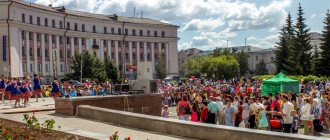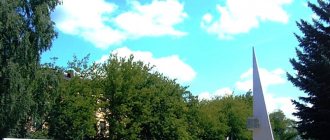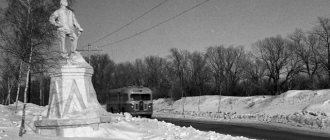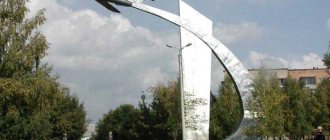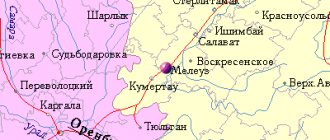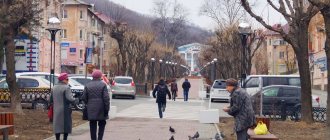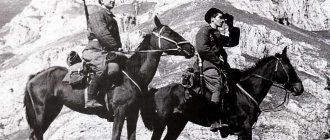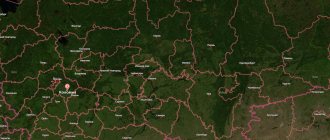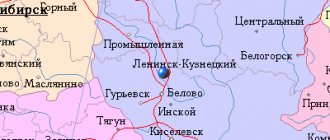| Folk heroes approve of this article. Therefore, they recommend continuing the text in the same spirit |
| Bogorodsk on the map | |
Red Square in the center of Bogorodsk Coat of arms of the city of Bogorodsk Bogorodsk. Boat trip on Lake Kabatskoe. 1953 Center s. Bogorodsky. View of the Chapel of Alexander II and the Church of the Resurrection of Christ Bogorodsk, view from above Bolshaya Street Bogorodsk, now st. Lenin. Pre-revolutionary photograph of the Fire Brigade of “Nizhkozhtrest”, Bogorodsk, Bragin St., 10. The photo was taken in 1933, the driver of the fire department, Nikolai Vasilievich Usilov, is driving. The moment of the opening of the monument to Alexander the Second “Liberator”. Bogorodsk, March 1913)
Bogorodsk
- a city of tanners, another well-known ancient industrial center of the Nizhny Novgorod region. Located away from the Oka River (8 kilometers), approximately halfway between Nizhny Novgorod and Pavlov.
History of Bogorodsk[edit]
Bogorodsk appeared in the sixteenth century, not yet as a city, but already as a village. The village of Bogorodskoye was formed by settlers who fell into disgrace from Veliky Novgorod under Tsar Ivan the Terrible. Some of the Novgorodians (about three hundred people) were settled on the territory of the Moscow state. Here, on the road located between Murom and Nizhny Novgorod, the settlement of Bogorodskoye appeared. The history of Bogorodsk as an economic center is in many ways similar to the history of Pavlov. Located on the same Moscow-Nizhny Novgorod road, it also from ancient times represented a large settlement, the lack of land of the peasants of which forced them to look for side sources of livelihood. And here “... the Sheremetev landowners (early 19th century) are memorable, who significantly contributed to the development of the fishery.” The emergence of leather crafts here is largely explained by the fact that exiled Novgorodians settled in Bogorodsk (in the second half of the 16th century), well acquainted with leather dressing.
Until the 17th century, similar to Pavlov, Bogorodsk was a palace village, then in 1615 it was granted to Minin “for his great service to Kuzmin” and “Moscow cleansing”, and in 1632, following Pavlov, Bogorodsk became the patrimony of the princely family of Cherkassy, and in the 18th century it became the possession of the Sheremetevs.
At the end of the 18th and beginning of the 19th centuries, when there were about 120 tanneries in Bogorodsk, it was already, like Pavlov, all-Russian. Bogorodsk leather goods (saddlery and mittens, the latter of which were produced up to one million pairs a year), were widely distributed throughout the country.
Raw materials in Bogorodsk were mainly imported from long distances and came from the lower Volga and other south-eastern steppe regions (bought at various auctions, including at the Nizhny Novgorod fair).
Working conditions at the Bogorodsk tanneries were hard labor; Many workers, where they worked, lived there, slept on vats of fermented skin, from which heavy fumes rose.
Pre-revolutionary Bogorodsk, numbering more than ten thousand inhabitants, was a mass of wooden, mostly one-story houses, huddled on a swampy lowland. Industrial buildings interspersed with residential ones, impassable mud on the muddy streets, waste from the leather industry lying everywhere, a river polluted by its waste, a heavy fetid smell that spread far beyond the city - such was the picture of old Bogorodsk.
After the Great October Socialist Revolution in Bogorodsk, on the site of several hundred small semi-handicraft and handicraft leather establishments that bore the loud name of factories, about a dozen large enterprises grew up, which were radically reconstructed and mechanized. For example, the labor-intensive manual ash of leather in vats was replaced by mechanized ash in drums.
In Soviet times, completely new enterprises were built in Bogorodsk - On the consideration of the sketch of the Coat of Arms of the city of Bogorodsk" the sketch of the Coat of Arms of the city of Bogorodsk, presented by the competition commission for consideration, was approved and recommended for approval by the Heraldic Commission of the Nizhny Novgorod Region and the Legislative Assembly of the Nizhny Novgorod Region. An appendix to this Resolution was a description of the Coat of Arms of the city of Bogorodsk:
| The coat of arms of the city of Bogorodsk is a shield with a given aspect ratio. The plane of the shield is divided in half by a horizontal line into two parts. At the top of the shield there is a figure of a deer: a walking scarlet deer in a silver field, black antlers and hooves - as a symbol of the city of Bogorodsk belonging to the Nizhny Novgorod region. The lower part of the shield is divided into three vertical parts. The two outer stripes are painted azure (in heraldry azure means beauty, softness, greatness) and represent two rivers - Oka and Kudma, between which the historical area of Berezopolye is located. It is symbolized by a wide central green stripe (in heraldry, greenery means hope, joy, abundance). On the green stripe in the center at the top there is an image of an Orthodox church (silver color, the head and cross are gold), symbolizing the Orthodox essence of the city’s name. In the lower part of the green stripe, three images of leather (gold) are symmetrically located, as a symbol of leather craft - the original occupation of the inhabitants of Bogorodsk, which became the basis of the well-being of the city and distinguishes it from other cities of the Nizhny Novgorod Province. |
Routes on the map of Bogorodsk. Transport infrastructure
P125 “Ryazhsk – Kasimov – Murom – Nizhny Novgorod” passes through the city .
From the Bogorodsk bus station (Dudenevsky Lane, 10, at the intersection of Dudenevsky Lane and Vokzalnaya Street) buses depart to Nizhny Novgorod and suburban settlements.
Within the city, the main form of public transport is buses.
Freight transportation is also carried out by water along the Oka River through the Dudenevo pier (7 kilometers from Bogorodsk).
From the Kozhevennoye railway station, located near Bogorodsk, only suburban services are provided. To travel to another city you need to make a transfer in Nizhny Novgorod.
Main streets of Bogorodsk
Today there are about 170 streets in the city. A detailed map of Bogorodsk will show not only major highways, but also small streets.
- Lenin Street. The main street of Bogorodsk.
It starts in the 2nd microdistrict from the intersection with Turkova Street.
It runs along the New Park.
Intersects with Molodezhnaya, Shchorsa, Shevchenko, Lermontov streets, Udalovsky Lane, Polevaya, Ulitskogo, Brenzissa, Kalinin streets.
It runs through the Central District of Bogorodsk, the district administration, Central Square, intersecting with Kotelnikov and Red Square streets.
Intersects with Leninsky, Kuznechny, Kopylov Shchurkin, Glukhim, Dudenevsky, Poksovsky lanes, Leninskaya site street.
It ends at the merger with Nizhny Novgorod Highway.
- Chernyshevsky street.
It starts from microdistrict 2, runs parallel to Lenin Street past the New Park, in which the Pobeda sports and recreation center is located. Intersects with Chernyshevsky Lane, Polevaya, Sportivnaya streets.
It ends with a transition to Lunacharsky Street.
- Karl Marx Street.
It originates from the intersection of Oktyabrskaya and Sakko streets, intersects with Karl Marx, Pesochny, Kuznechny, Dudenevsky lanes. It ends at the intersection with Poksovsky Lane.
- Kashina street.
Starts from the intersection with Zagorodnaya Street.
Intersects with the streets of Mira, Gaidar, Pervomaiskaya, Novaya, Chkalov, Liebknecht, Uritsky, Volodarsky, Bragin, Pravda. It ends at the intersection with Kotelnikov Street.
- Mechanizer Street.
It originates from the intersection with Polevaya Street.
It runs along the railway and Kozhevennoye station.
Intersects with Rodionova Street.
It ends with a transition to 2nd Vokzalnaya Street.
City of artisans
The history of the city is not simple and special. Despite this, the city has preserved places that are worth visiting. And Bogorodsk is famous for its settlement, jacks of all trades. Excellent quality leather was produced here. The quarter of the tanners' settlement on the shore of the Kabatsky swamp is memorable. They soaked the skins in water. The Tsarev Tavern was previously located there. It’s convenient, you’ve done the job - go for a walk safely. The work of tanners was in great demand, craftsmen were valued for quite a penny, and over time the houses began to grow into solid estates.
We should not forget about the pottery craft, which existed since the foundation of the village. Locals recommend visiting the Museum of Contemporary Ceramics, where you can:
- Book a tour accompanied by a guide.
- Get acquainted with the best examples of pottery and exhibits collected from all over Russia.
- Take an unforgettable master class that will give you a lot of impressions and reward you with new skills.
In addition, the museum has a souvenir shop where you can buy gifts for yourself and your loved ones at reasonable prices.
Notes
- Nizhny Novgorod Region. Total land area of the municipality
- 123 Population of the Russian Federation by municipalities as of January 1, 2021 (Russian). Retrieved July 31, 2019.
- 12 USSR. Administrative-territorial division of the union republics on January 1, 1980 / Comp. V. A. Dudarev, N. A. Evseeva. - M.: Izvestia, 1980. - 702 p. — P. 118.
- Register of administrative-territorial entities, urban and rural settlements of the Nizhny Novgorod region dated January 15, 2019
- Charter of the city of Bogorodsk, Nizhny Novgorod region
- Esperantistov Lane on the map of Bogorodsk
- AT THE ORIGINS OF SETTLEMENTS
- Pospelov E. M. Geographical names of the world: Toponymic dictionary: About 5000 units. 2nd ed. - M.: Astrel, AST, 2001. - 512 p. — ISBN 5-17-002938-1.. — P. 71.
- 1234567891011121314 People's encyclopedia “My City”. Bogorodsk
- All-Union Population Census of 1959. The size of the urban population of the RSFSR, its territorial units, urban settlements and urban areas by gender (Russian). Demoscope Weekly. Retrieved September 25, 2013. Archived April 28, 2013.
- All-Union Population Census of 1970 The size of the urban population of the RSFSR, its territorial units, urban settlements and urban areas by gender. (Russian). Demoscope Weekly. Retrieved September 25, 2013. Archived April 28, 2013.
- All-Union Population Census of 1979 The size of the urban population of the RSFSR, its territorial units, urban settlements and urban areas by gender. (Russian). Demoscope Weekly. Retrieved September 25, 2013. Archived April 28, 2013.
- All-Union population census of 1989. Urban population (undefined). Archived from the original on August 22, 2011.
- Resolution of the Legislative Assembly of the region dated June 17, 1999 No. 184 “On establishing a formula for calculating the amount of the single tax on imputed income, the value of the basic profitability, increasing (decreasing) coefficients in the field of retail trade in the Nizhny Novgorod region” (undefined). Retrieved May 2, 2021. Archived May 2, 2021.
- 12 All-Russian Population Census 2010. Number and distribution of the population of the Nizhny Novgorod region (unspecified). Retrieved July 30, 2014. Archived July 30, 2014.
- 123 Nizhny Novgorod region. Estimated resident population as of January 1, 2008-2016
- Population of the Russian Federation by municipalities. Table 35. Estimated resident population as of January 1, 2012 (unspecified). Retrieved May 31, 2014. Archived May 31, 2014.
- Population of the Russian Federation by municipalities as of January 1, 2013. - M.: Federal State Statistics Service Rosstat, 2013. - 528 p. (Table 33. Population of urban districts, municipal districts, urban and rural settlements, urban settlements, rural settlements) (undefined). Retrieved November 16, 2013. Archived November 16, 2013.
- Table 33. Population of the Russian Federation by municipalities as of January 1, 2014 (unspecified). Retrieved August 2, 2014. Archived August 2, 2014.
- Population of the Russian Federation by municipalities as of January 1, 2021 (unspecified). Retrieved August 6, 2021. Archived August 6, 2015.
- Population of the Russian Federation by municipalities as of January 1, 2021
- Population of the Russian Federation by municipalities as of January 1, 2021 (Russian) (July 31, 2017). Retrieved July 31, 2021. Archived July 31, 2021.
- Population of the Russian Federation by municipalities as of January 1, 2021 (Russian). Retrieved July 25, 2018. Archived July 26, 2021.
- taking into account the cities of Crimea
- Population of the Russian Federation by municipalities as of January 1, 2021. Table “21. Population of cities and towns by federal districts and constituent entities of the Russian Federation as of January 1, 2021” (unspecified) (RAR archive (1.0 MB)). Federal State Statistics Service.
- GOU SPO BMK - Home page
- Home | Official website of the State Educational Institution of Secondary Professional Education "Bogorodsky Polytechnic College" (unspecified) (inaccessible link - history).
- MBUK Bogorodsky Historical Museum (unspecified) (inaccessible link). Archived from the original on May 21, 2013.
- Nizhny Novgorod regional flying club
- The L-410 high-altitude aircraft (unspecified) arrives at the DZ Bogorodsk airfield. Sky-master (2018).
Palace of Count Bobrinsky
The palace is located on the territory of the estate; it was erected on the initiative of Catherine II, as a gift to her illegitimate son, Count Alexei Bobrinsky. The palace is a luxurious two-story white stone building with a high base and a semicircular projection on the western part of the facade. At the entrance to the complex you can see the Entrance Tower, also known as the bell tower - this is the gate to the count's lands. Contains construction features characteristic of the Baroque style. The gate is decorated in the same spirit as other buildings in the complex.
